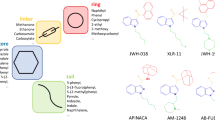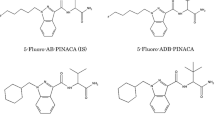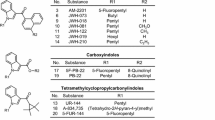Abstract
In February 2015, 13 “spice-like” products, available on the German market, were analyzed. In total, eight different synthetic cannabinoids were identified by gas chromatography–mass spectrometry (GC–MS), namely 5-fluoro-AB-PINACA, AB-CHMINACA, AB-FUBINACA, 5-fluoro-PB-22, 5-fluoro-AMB, MDMB-CHMICA, EAM-2201 and STS-135. In most of the products (11/13), only one synthetic cannabinoid was identified, while two products contained two or three synthetic cannabinoids. For some of the compounds (5-fluoro-AB-PINACA, AB-CHMINACA, 5-fluoro-AMB) only insufficient physicochemical data are available in literature. To our knowledge MDMB-CHMICA (sometimes mistakenly referred to as MBMD-CHMINACA) was not described earlier in scientific literature, and, hence, an in-depth characterization of these compounds by nuclear magnetic resonance (NMR) spectroscopy, electron ionization–mass spectroscopy, electrospray ionization–tandem mass spectroscopy (ESI-MS/MS), infrared spectroscopy and ultraviolet spectroscopy was conducted for eight compounds. In addition, we developed an ESI-MS method for the direct quantification of synthetic cannabinoids in commercial smoking blends, without chromatographic separation. Quantification was achieved using methyl 3-(3-(1-naphthoyl)-1H-indol-1-yl)propionate as the internal standard with appropriate response factors. The total contents of synthetic cannabinoids in the investigated products ranged from 60 to 446 mg/g, while individual compounds ranged from 12 to 314 mg/g.




Similar content being viewed by others
References
Auwärter V, Dresen S, Weinmann W, Müller M, Pütz M, Ferreiro N (2009) Spice and other herbal blends: harmless incense or cannabinoid designer drugs? J Mass Spectrom 44:832–837
Lindigkeit R, Boehme A, Eiserloh I, Luebbecke M, Wiggermann M, Ernst L, Beuerle T (2009) Spice: a never ending story? Forensic Sci Int 191:58–63
EMCDDA (2014) European drug report 2014: trends and developments, May 2014. http://www.emcdda.europa.eu/attachements.cfm/att_228272_EN_TDAT14001ENN.pdf. Accessed May 2015
UNODC (2014) World drug report 2014, June 2014. http://www.unodc.org/documents/wdr2014/World_Drug_Report_2014_web.pdf. Accessed May 2015
UNODC (2015) Decision 58/10 and 58/11. https://www.unodc.org/unodc/en/commissions/CND/Resolutions_Decisions/Resolutions-Decisions_2010-2019.html. Accessed Sept 2015
Kikura-Hanajiri R, Uchiyama N, Kawamura M, Goda Y (2014) Changes in the prevalence of new psychoactive substances before and after the introduction of the generic scheduling of synthetic cannabinoids in Japan. Drug Test Anal 6:832–839
28. BtMÄndV 2014, 13. December 2014. http://www.bgbl.de/banzxaver/bgbl/start.xav?start=%2F%2F*%5B%40attr_id%3D’bgbl104s0028.pdf’%5D#__bgbl__%2F%2F*%5B%40attr_id%3D%27bgbl114s1999.pdf%27%5D__1427399651317. Accessed May 2015
EU-Court (2014) Judgment of the court (Fourth Chamber), 10 July 2014. Medicinal products for human use. Joined cases C-358/13 and C-181/14. http://curia.europa.eu/juris/liste.jsf?language=de&num=C-358/13. Accessed May 2015
Bundesgerichtshof (2015) StR 302/13. 14. January 2015. http://juris.bundesgerichtshof.de/cgi-bin/rechtsprechung/document.py?Gericht=bgh&Art=en&nr=70354&pos=0&anz=1. Accessed May 2015
SWGDRUG (2014) SWGDRUG mass spectral library. http://www.swgdrug.org/ms.htm. Accessed Feb 2015
Cayman Chemical (2014) Cayman spectral library. https://www.caymanchem.com/app/template/SpectralLibrary.vm. Accessed Feb 2015
Lovett DP, Yanes EG, Herbelin TW, Knoerzer TA, Levisky JA (2013) Structure elucidation and identification of a common metabolite for naphthoylindole-based synthetic cannabinoids using LC–TOF and comparison to a synthetic reference standard. Forensic Sci Int 226:81–87
Langer N, Lindigkeit R, Schiebel HM, Ernst L, Beuerle T (2014) Identification and quantification of synthetic cannabinoids in ‘spice-like’ herbal mixtures: a snapshot of the German situation in the autumn of 2012. Drug Test Anal 6:59–71
Wurita A, Hasegawa K, Minakata K, Watanabe K, Suzuki O (2014) A large amount of new designer drug diphenidine coexisting with a synthetic cannabinoid 5-fluoro-AB-PINACA found in a dubious herbal product. Forensic Toxicol 32:331–337
Wohlfarth A, Castaneto MS, Zhu M, Pang S, Scheidweiler KB, Kronstrand R, Huestis MA (2015) Pentylindole/pentylindazole synthetic cannabinoids and their 5-fluoro analogs produce different primary metabolites: metabolite profiling for AB-PINACA and 5F-AB-PINACA. AAPS J 17:660–677
Hasegawa K, Wurita A, Minakata K, Gonmori K, Nozawa H, Yamagishi I, Watanabe K, Suzuki O (2015) Postmortem distribution of AB-CHMINACA, 5-fluoro-AMB, and diphenidine in body fluids and solid tissues in a fatal poisoning case: usefulness of adipose tissue for detection of the drugs in unchanged forms. Forensic Toxicol 33:45–53
Uchiyama N, Shimokawa Y, Kawamura M, Kikura-Hanajiri R, Hakamatsuka T (2014) Chemical analysis of a benzofuran derivative, 2-(2-ethylaminopropyl)benzofuran (2-EAPB), eight synthetic cannabinoids, five cathinone derivatives, and five other designer drugs newly detected in illegal products. Forensic Toxicol 32:266–281
Uchiyama N, Shimokawa Y, Kikura-Hanajiri R, Demizu Y, Goda Y, Hakamatsuka T (2015) A synthetic cannabinoid FDU-NNEI, two 2H-indazole isomers of synthetic cannabinoids AB-CHMINACA and NNEI indazole analog (MN-18), a phenethylamine derivative N-OH-EDMA, and a cathinone derivative dimethoxy-α-PHP, newly identified in illegal products. Forensic Toxicol 33:244–259
Takayama T, Suzuki M, Todoroki K, Inoue K, Min JZ, Kikura-Hanajiri R, Goda Y, Toyo'oka T (2014) UPLC/ESI–MS/MS-based determination of metabolism of several new illicit drugs, ADB-FUBINACA, AB-FUBINACA, AB-PINACA, QUPIC, 5F-QUPIC and α-PVT, by human liver microsome. Biomed Chromatogr 28:831–838
Uchiyama N, Matsuda S, Wakana D, Kikura-Hanajiri R, Goda Y (2013) New cannabimimetic indazole derivatives, N-(1-amino-3-methyl-1-oxobutan-2-yl)-1-pentyl-1H-indazole-3-carboxamide (AB-PINACA) and N-(1-amino-3-methyl-1-oxobutan-2-yl)-1-(4-fluorobenzyl)-1H-indazole-3-carboxamide (AB-FUBINACA) identified as designer drugs in illegal products. Forensic Toxicol 31:93–100
Chung H, Choi H, Heo S, Kim E, Lee J (2014) Synthetic cannabinoids abused in South Korea: drug identifications by the National Forensic Service from 2009 to June 2013. Forensic Toxicol 32:82–88
Shevyrin V, Melkozerov V, Nevero A, Eltsov O, Shafran Y (2013) Analytical characterization of some synthetic cannabinoids, derivatives of indole-3-carboxylic acid. Forensic Sci Int 232:1–10
Behonick G, Shanks KG, Firchau DJ, Mathur G, Lynch CF, Nashelsky M, Jaskierny DJ, Meroueh C (2014) Four postmortem case reports with quantitative detection of the synthetic cannabinoid, 5F-PB-22. J Anal Toxicol 38:559–562
Buchler IP, Hayes MJ, Hegde SG, Hockerman SL, Jones DE, Kortum SW, Rico JG, Tenbrink RE, Wu KK (2009) Indazole derivatives as CB1 receptor modulators and their preparation and use in treatment of diseases. Patent WO/2009/106980, Sept 2009
Banister SD, Stuart J, Kevin RC, Edington A, Longworth M, Wilkinson SM, Beinat C, Buchanan AS, Hibbs DE, Glass M, Connor M, McGregor IS, Kassiou M (2015) Effects of bioisosteric fluorine in synthetic cannabinoid designer drugs JWH-018, AM-2201, UR-144, XLR-11, PB-22, 5F-PB-22, APICA, and STS-135. Chem Neurosci 6:1445–1458
Uchiyama N, Matsuda S, Wakana D, Kikura-Hanajiri R, Goda Y (2013) URB-754: a new class of designer drug and 12 synthetic cannabinoids detected in illegal products. Forensic Sci Int 227:21–32
Musah RA, Domin MA, Walling MA, Shepard JRE (2012) Rapid identification of synthetic cannabinoids in herbal samples via direct analysis in real time mass spectrometry. Rapid Commun Mass Spectrom 26:1109–1114
Grange AH, Sovocool G (2011) Detection of illicit drugs on surfaces using direct analysis in real time (DART) time-of-flight mass spectrometry. Rapid Commun Mass Spectrom 25:1271–1281
Lesiak AD, Musah RA, Domin MA, Shepard JRE (2014) DART-MS as a preliminary screening method for “herbal incense”: chemical analysis of synthetic cannabinoids. J Forensic Sci 59:337–343
Moosmann B, Angerer V, Auwärter V (2015) Inhomogeneities in herbal mixtures: a serious risk for consumers. Forensic Toxicol 33:54–60
Seely KA, Prather PL, James LP, Moran JH (2011) Marijuana-based drugs: innovative therapeutics or designer drugs of abuse? Mol Interv 11:36–51
Ogata J, Uchiyama N, Kikura-Hanajiri R, Goda Y (2013) DNA sequence analyses of blended herbal products including synthetic cannabinoids as designer drugs. Forensic Sci Int 227:33–41
Simolka K, Lindigkeit R, Schiebel H-M, Papke U, Ernst L, Beuerle T (2012) Analysis of synthetic cannabinoids in “spice-like” herbal highs: snapshot of the German market in summer 2011. Anal Bioanal Chem 404:157–171
Ernst L, Krüger K, Lindigkeit R, Schiebel H-M, Beuerle T (2012) Synthetic cannabinoids in “spice-like” herbal blends: first appearance of JWH-307 and recurrence of JWH-018 on the German market. Forensic Sci Int 222:216–222
Acknowledgments
This work was supported by Zentrales Innovationsprogramm Mittelstand (ZIM) des Bundesministeriums für Wirtschaft und Energie (BMWI) FKZ: KF31565015K3. The authors express their gratitude to Lisa Sieverling, Judith Carla Schürmann and Kerstin Ollenborger for their helpful assistance.
Author information
Authors and Affiliations
Corresponding author
Ethics declarations
Conflict of interest
There are no financial or other relations that could lead to a conflict of interest.
Ethical approval
This article does not contain any studies with human participants or animals performed by any of the authors.
Electronic supplementary material
Below is the link to the electronic supplementary material.
Rights and permissions
About this article
Cite this article
Langer, N., Lindigkeit, R., Schiebel, HM. et al. Identification and quantification of synthetic cannabinoids in “spice-like” herbal mixtures: update of the German situation for the spring of 2015. Forensic Toxicol 34, 94–107 (2016). https://doi.org/10.1007/s11419-015-0292-7
Received:
Accepted:
Published:
Issue Date:
DOI: https://doi.org/10.1007/s11419-015-0292-7




